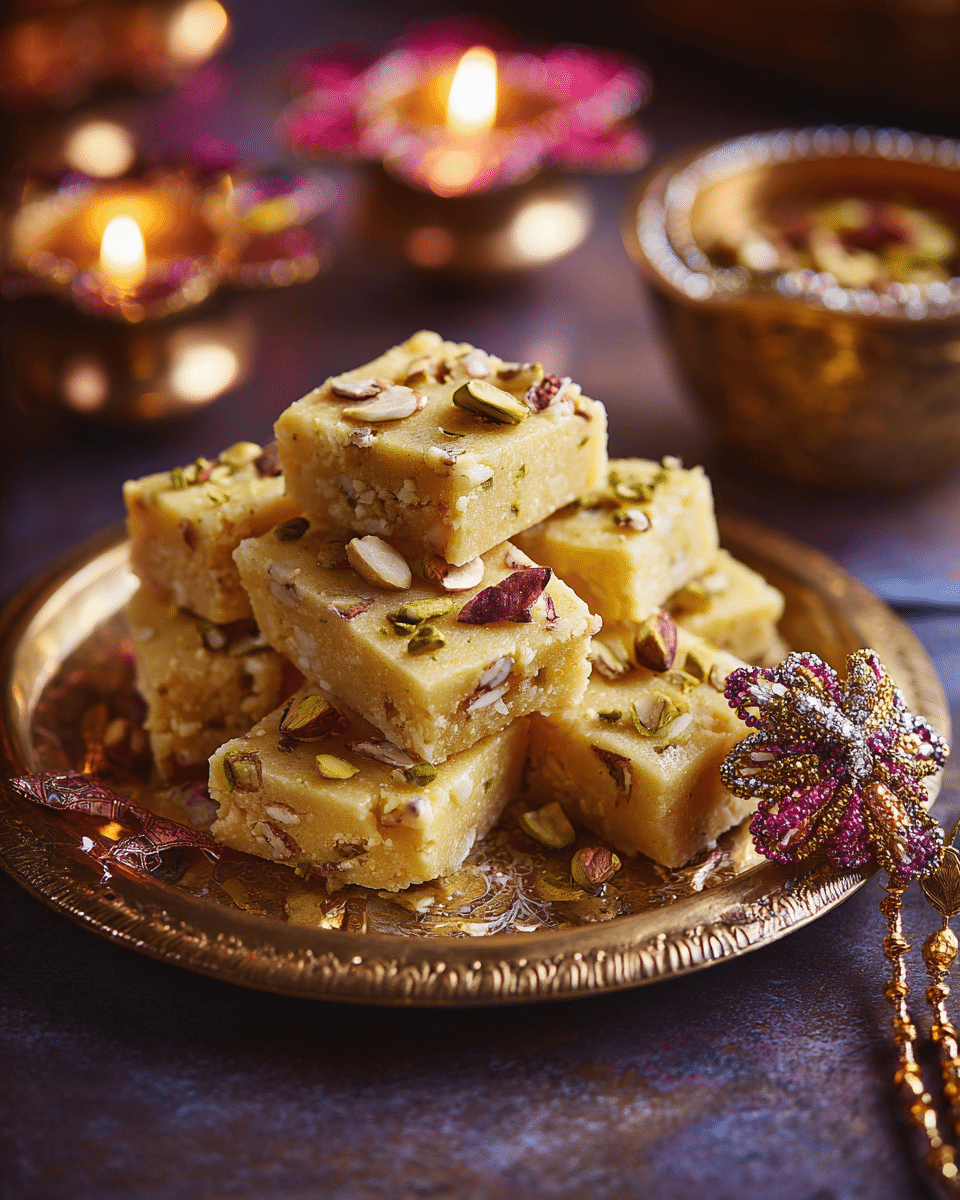Soan Papdi is a traditional Indian sweet known for its delicate, flaky texture and melt-in-the-mouth quality. Often enjoyed during festivals like Rakhi and Diwali, this dessert is made from a blend of gram flour, all-purpose flour, sugar, and ghee, infused with cardamom and garnished with slivered nuts. Its crisp, fibrous layers make it a unique confection that requires precision but rewards with indulgent sweetness and a festive feel.
FULL RECIPE
Ingredients
- 1 cup gram flour (besan)
- 1 cup all-purpose flour (maida)
- 1 cup ghee (clarified butter)
- 2 cups sugar
- ½ cup water
- 1 teaspoon cardamom powder
- 2 tablespoons milk (optional, for softening texture)
- 2 tablespoons slivered almonds
- 2 tablespoons slivered pistachios
Directions
- Begin by sifting the gram flour and all-purpose flour together into a large mixing bowl to remove lumps and ensure an even blend.
- Heat the ghee in a heavy-bottomed pan over medium heat. Once melted, add the flour mixture to the pan, stirring continuously to prevent burning. Roast this mixture on low to medium heat until it turns golden and aromatic, about 12–15 minutes. Set aside to cool slightly.
- In a separate pan, combine the sugar and water. Stir well and bring to a boil over medium heat. Continue cooking until the syrup reaches a two-thread consistency. This step is crucial, as it determines the flaky texture of the final sweet.
- Once the syrup reaches the right consistency, immediately pour it into the roasted flour mixture. Quickly add cardamom powder and mix thoroughly using a flat spatula. Stir constantly until the mixture thickens and starts leaving the sides of the pan.
- Transfer the hot mixture onto a greased surface or parchment-lined tray. Allow it to cool for a minute, then use a spatula or knife to stretch and fold the mixture repeatedly while it’s still warm to develop the flaky strands.
- Spread the mixture evenly into a rectangular or square shape about 1 inch thick. Press gently and smooth the surface.
- Garnish with slivered almonds and pistachios, pressing them lightly into the surface.
- Once fully cooled, cut the soan papdi into square or diamond-shaped pieces using a sharp knife. Store in an airtight container at room temperature for up to a week.
Nutrition Facts
- Calories: 180
- Total Fat: 10g
- Saturated Fat: 6g
- Cholesterol: 20mg
- Sodium: 10mg
- Total Carbohydrates: 20g
- Dietary Fiber: 1g
- Sugars: 15g
- Protein: 2g
- Calcium: 1% DV
- Iron: 4% DV
History and Cultural Significance of Soan Papdi
Soan Papdi is a beloved traditional Indian sweet with a rich history tracing back to the Mughal era. Its origins are thought to be in North India, where the art of making flaky, spun sugar sweets was perfected. Over time, it has become a staple for festivals and celebrations, especially during Rakhi and Diwali. Its intricate flaky texture symbolizes patience and skill in Indian confectionery, and sharing Soan Papdi is often associated with bonding and festive joy. The sweet’s cultural importance extends beyond India, embraced by Indian communities worldwide as a nostalgic treat that connects them to their heritage.
The Unique Texture and Preparation Technique
What makes Soan Papdi truly special is its characteristic flaky, fibrous texture, which sets it apart from other Indian sweets. This texture is achieved through a precise combination of roasting flours and boiling sugar syrup to a specific consistency, followed by a rapid folding and stretching technique while the mixture is still warm. The process requires skill to ensure that the sweet does not become too hard or sticky. The delicate layers melt instantly on the tongue, providing a unique sensory experience that is both crispy and airy, making Soan Papdi a marvel of culinary craftsmanship.
Health Benefits and Nutritional Considerations
While Soan Papdi is primarily a dessert, it does have some nutritional benefits due to its ingredients. Gram flour (besan) is rich in protein and fiber, aiding digestion and providing a moderate source of energy. Cardamom, often used in the recipe, offers digestive benefits and has antioxidant properties. However, it is important to consume Soan Papdi in moderation due to its high sugar and ghee content, which contribute to calories and saturated fats. For those mindful of health, small portions can satisfy sweet cravings without excessive indulgence.
Common Variations and Flavor Twists
Though the classic Soan Papdi recipe is widely loved, there are numerous variations that add interesting flavors and textures. Some versions incorporate saffron strands for a luxurious aroma and golden hue, while others add rose water or kewra essence to enhance floral notes. Nut toppings can vary from pistachios and almonds to cashews or even edible silver foil for a festive touch. Regional adaptations sometimes include cocoa or chocolate flavoring for a modern twist. These variations allow the traditional recipe to evolve and appeal to different palates while retaining its signature flaky texture.
Serving Suggestions and Presentation Ideas
Soan Papdi is traditionally served at room temperature, cut into neat square or diamond-shaped pieces. For special occasions, the sweet can be elegantly plated alongside other mithai, garnished with extra chopped nuts or edible silver leaf to elevate its visual appeal. It pairs wonderfully with hot beverages like masala chai or coffee, as the warmth complements the rich, buttery sweetness. For gifting, it is commonly packed in decorative boxes, making it an ideal festive or celebratory present that conveys warmth and tradition.
Perfect Pairings with Soan Papdi
The delicate sweetness and flaky texture of Soan Papdi lend themselves well to pairing with a variety of foods and drinks. Traditional Indian chai, especially masala chai with its aromatic spices, is the most popular accompaniment, as its bold flavors balance the sweetness. For those seeking non-traditional pairings, a lightly brewed green tea or mild coffee offers a subtle contrast. It also complements fruits like ripe mangoes or pomegranate seeds, providing a refreshing balance of flavors. These pairings enhance the overall tasting experience by combining texture and flavor contrasts.
Storage Tips for Maintaining Freshness
Storing Soan Papdi properly is essential to preserve its unique flaky texture and prevent it from becoming sticky or hard. The sweet should be kept in an airtight container at room temperature, away from humidity and direct sunlight. Exposure to moisture can cause it to lose its crispness quickly. If stored well, Soan Papdi can stay fresh for up to a week. Refrigeration is generally discouraged as the moisture inside the fridge can negatively affect texture. For longer storage, freezing is possible but may alter the delicate layers once thawed.
Tips for Making Soan Papdi at Home
Making Soan Papdi from scratch requires patience and precise timing, especially when working with hot sugar syrup. One key tip is to monitor the syrup’s consistency carefully; achieving the two-thread stage is critical to getting the right texture. Using a heavy-bottomed pan helps prevent burning the mixture. Additionally, roasting the flours evenly without browning too much ensures the right nutty flavor. When folding the mixture, act quickly but gently to create the flaky strands. Watching tutorial videos and practicing can improve results, as homemade Soan Papdi often tastes fresher and more aromatic than store-bought versions.
Commercial Production and Availability
Soan Papdi is widely available in Indian sweet shops and supermarkets, especially during festival seasons. Commercial production uses large-scale machines to replicate the delicate folding process, enabling mass production while maintaining quality. Popular brands package Soan Papdi in attractive boxes for gifting purposes. While commercially made Soan Papdi is convenient and often affordable, it can sometimes be sweeter and less flaky compared to homemade varieties. Consumers often look for authentic handmade options or artisanal brands that prioritize traditional methods and high-quality ingredients.
Soan Papdi in Modern Cuisine and Fusion Recipes
In recent years, Soan Papdi has inspired chefs and home cooks to incorporate it into innovative fusion desserts. Crumbled Soan Papdi is used as a crunchy topping for ice creams and puddings, adding texture and sweetness. It is sometimes blended into cake batters or cookie doughs to infuse an Indian twist into Western baked goods. Creative dessert bars and parfaits layer Soan Papdi with fruits and creams to create visually appealing dishes. This experimentation keeps the sweet relevant to younger generations and global palates, while celebrating its traditional roots.
Conclusion
Soan Papdi remains an iconic Indian sweet that combines rich cultural heritage with a uniquely delightful texture and flavor. Its intricate preparation and flaky layers make it a standout dessert during festivals and celebrations. While it offers some nutritional benefits through its core ingredients, it is best enjoyed in moderation as a special treat. Whether savored traditionally with chai, gifted in decorative boxes, or adapted into modern recipes, Soan Papdi continues to charm sweet lovers worldwide, preserving its timeless appeal for generations to come.






